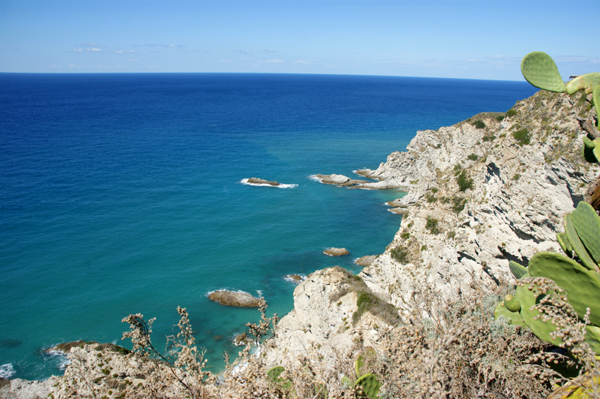Capo Vaticano - Sights
"The coastal area which ends at Capo Vaticano is rich in history and beauty. It could, with a bit of regret and nostalgia, be called Costabella" - this is what Giuseppe Berto, a well-known Italian writer, once wrote (Costabella = “beautiful coast”).
Capo Vaticano - Sights
"The coastal area which ends at Capo Vaticano is rich in history and beauty. It could, with a bit of regret and nostalgia, be called Costabella" - this is what Giuseppe Berto, a well-known Italian writer, once wrote (Costabella = “beautiful coast”).
Capo Vaticano: Sandy beaches and charming bays with fantastic panorama
Calabria – a dream: Between romantic, small Pizzo to the north and Nicotera, which sits enthroned upon a rock to the south, medieval, picturesque Tropea rises majestically on a cliff above the sea.
In-between also lies the wild-romantic rocky coast of Southern Italy’s Capo Vaticano with its charming beach bays and gorgeous views of the coast and of the Lipari Islands. It is not without reason that the white sandy beaches with Caribbean-like atmosphere are considered the most beautiful of Calabria.
The old villages on and around Capo Vaticano are rich in history, legend, folklore and tradition
The best-known town on the cape is Tropea, famous for its crystal clear sea waters and white beaches. Tropea, once residence of the nobility, with numerous old palaces and churches, e.g. the Norman cathedral, adorning its townscape, with its narrow alleys, countless stores and elegant atmosphere, is found in amazing location on a cliff above the picturesque beach and counts among the pearls of Italy.
Further to the north lies another place worth stopping by - the coastal town of Pizzo with its medieval alleys and its impressive castle, which was built by order of Ferdinand of Aragon in 1486 and where Gioacchino Murat, cavalry general and former king of Naples, was shot in 1815.
Greeks from Locri founded Vibo Valentia, east of Tropea. Today you get to admire, amongst others, the ruins of the ancient temple site, once built for the worship of Proserpina, old town walls, Villa Sicea, where Cicero visited, and, last but not least, above the town, the Swabian-Norman castle, which was erected upon the site of an old acropolis.
Mention be made here also of Nicotera. Castello dei Ruffo, which was erected on top of the acropolis, dates back to the 17th century, the old town center dates back to the 18th century.
Apart from these towns there are of course a lot of other places at and around Capo Vaticano which are worth stopping by and having a closer look at.
The legend of Donna Canfora
The legend of Donna Canfora, a beautiful and rich woman from Ricadi, came into being on the beach of Torre Ruffa – only a few kilometers south of Tropea. Dona Canfora, so the story goes, was taken prisoner by the Saracens. After bidding her friends farewell, she jumped from the Saracen ship into the sea and called out: “The women of this town rather die than lose their honor!” Then she disappeared into the waves. From this time on, the waters of the sea around Torre Ruffa have been as blue as the veil Donna Canfora had worn. When the waves break at the rocks, you can still hear her grief as she bids her country farewell...
„Cilentano - We know Southern Italy!“


Contact us by email or phone (Mon - Fri 09:30 h - 17:00 h):
0049 941 / 56 76 46-0


